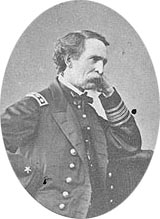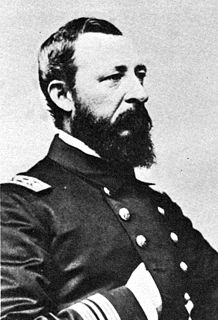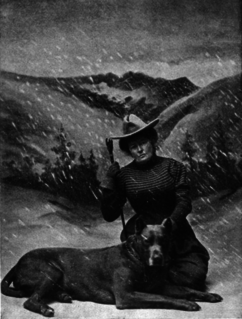
USS Dale (1839) was a sloop-of-war in the United States Navy commissioned on 11 December 1839. Dale was involved in the Mexican–American War, the American Civil War, operations along Africa to suppress slave trade, and was used in the U.S. Coast Guard, among other activities. Dale was placed into ordinary numerous times.

Rear Admiral Alexander Murray was a flag officer in the United States Navy, who served during the Mexican–American War and the American Civil War.

Daniel Ammen was a U.S. naval officer during the American Civil War and the postbellum period, as well as a prolific author. His last assignment in the Navy was Chief of the Bureau of Navigation.

The Pacific Squadron was part of the United States Navy squadron stationed in the Pacific Ocean in the 19th and early 20th centuries. Initially with no United States ports in the Pacific, they operated out of storeships which provided naval supplies and purchased food and obtained water from local ports of call in the Hawaiian Islands and towns on the Pacific Coast. Throughout the history of the Pacific Squadron, American ships fought against several enemies. Over one-half of the United States Navy would be sent to join the Pacific Squadron during the Mexican–American War. During the American Civil War, the squadron was reduced in size when its vessels were reassigned to Atlantic duty. When the Civil War was over, the squadron was reinforced again until being disbanded just after the turn of the 20th century.

James Alden Jr. was a rear admiral in the United States Navy. In the Mexican–American War he participated in the captures of Veracruz, Tuxpan, and Tabasco. Fighting on the Union side in the Civil War, he took part in the relief of Fort Pickens, followed by many engagements on the Lower Mississippi, before being promoted captain of USS Brooklyn and assisting in the Union victory in the Battle of Mobile Bay.

The second USS Savannah was a frigate in the United States Navy. She was named after the city of Savannah, Georgia.

George Beall Balch was a Rear Admiral in the United States Navy who served during the Mexican–American War and the American Civil War.

Andrew Ellicot Kennedy Benham was an American admiral. In his early career, he served in China, the Pacific and Paraguay. During the American Civil War, he took part in the capture of Port Royal, South Carolina, and patrolled the Texas coast as part of the West Gulf Blockading Squadron.

In the California coast, the use of ships and the Pacific Ocean has historically included water craft, fisheries, shipbuilding, Gold Rush shipping, ports, shipwrecks, naval ships and installations, and lighthouses. The maritime history of California can be divided into several periods: the Native American period; European exploration period from 1542 to 1769; the Spanish colonial period, 1769 to 1821; the Mexican period, 1821 to 1847; and United States statehood period, which continues to the present day.
USS Edith may refer to the following ships of the United States Navy:

Cadwalader Ringgold was an officer in the United States Navy who served in the United States Exploring Expedition, later headed an expedition to the Northwest and, after initially retiring, returned to service during the Civil War.

Rear Admiral John Irwin was an officer in the United States Navy. He participated in the African Slave Trade Patrol, fought in the American Civil War, and served as commander of the Asiatic and Pacific Squadrons.
Commodore Jonathan Young was an officer in the United States Navy. He participated in anti-piracy actions and the African Slave Trade Patrol, fought in the Mexican War, Puget Sound War, and American Civil War, and served briefly as commander of the Asiatic Squadron.

Captain Robert F. R. Lewis was an officer in the United States Navy. He participated in the Paraguay Expedition, fought in the Mexican War and American Civil War, and served briefly as commander of the Asiatic Squadron.

Commodore Cicero Price was an officer in the United States Navy. He served in the American Civil War and was commander of the East India Squadron.

John Cummings Howell was an officer in the United States Navy during the American Civil War. He rose to the rank of rear admiral and late in his career was commander-in-chief of the North Atlantic Squadron and then of the European Squadron.

William Edgar Le Roy was an officer in the United States Navy who served in the Mexican War, on the African Slave Trade Patrol, and in the American Civil War. He rose to the rank of rear admiral and late in his career was consecutively commander-in-chief of the South Atlantic Squadron, the North Atlantic Squadron, and the European Squadron.

Gustavus Hall Scott was an officer in the United States Navy who served in the Second Seminole War and the American Civil War. He rose to the rank of rear admiral and late in his career was commander-in-chief of the North Atlantic Squadron.
Edward Tatnall Nichols was a United States Navy rear admiral.

Mary Evelyn Hitchcock was an American author and explorer. She was part of the Floradora Company in the early 20th century, and also worked from the New York World as a reporter.
















